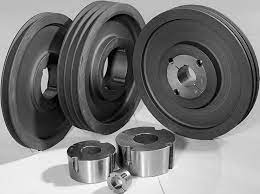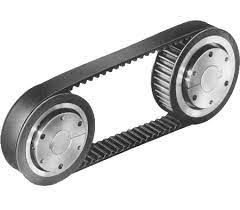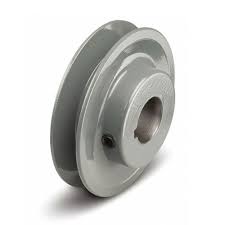Product Description
China Foundry Ductile Iron Motor Drive Pulley
Product Introduction
Material: Ductile iron, Stainless steel , Steel, Grey iron, Aluminium alloy, Copper alloy and so on.
Process: Sand Casting.
Heat Treatment: Quenching, Tempering, Annealing, Normalizing, Nitridation, Carburization.
Surface Treatment: Zinc-Plated, Hot dipping galvanized, Polishing, Painting, Powder coating.
Machining Equipment: CNC Machines, Turning Machines,Drilling Machines , Milling Machines, Grinding Machines,etc.
Measuring Tool: CMM, Projector, Vernier Caliper, Depth Caliper, Micrometer, Pin Gauge, Thread Gauge, Height Gauge, etc.
Weight: 0.1-3000kgs.
Application: Machinery Parts, Construction Industry, etc.
Package: Plywood or wooden case, pallet (As per customer’s requirement).
Manufacturing process
1. Sample or Drawing by customer
2. Tooling proposal&Discussion
3.3D Tooling Design
4. Tooling production
5. Rough parts manufacturer
6. CNC Machining
7. Fitting&Finish
8. Tooling Measurement&Check
9. Assembly
10. Trial Production
11. Correction
12. Final Trial
13. Samples Inspection
14. Sample Approval by customer
15. Tooling Approval
16. ISO9001 high quality brass forging
Our Inspection Equipment:
Direct-reading spectrograph,metallographic microscope,hardness tester,brinell hardness tester,thermometric indicator,universal testing machine,carbon and silicon analysis meter,magnetic powder flaw detector,digital ultrasonic flaw detector etc.
Our Service:
1.Your inquiry related to our products or prices will be replied in 12 hours.
2.Individual formula according to customers’ special drawing requests.
3.Manufacturer with large capacity,ensures the fast production cycle after
confirming the order.
4.Protection of sales area and private information for all of our customers.
Quality Control:
We have a full set of quality control system to guarantee best product quality. Depending on the products, we can make different Item Testing Plan, Manufacturing procedure etc.
Raw material control
Chemistry spectrum analysis
Mechanical property
Metallographic analysis
Ultrasonic testing
Magnetic testing
Radiographic testing
Dimension inspection
Visual inspection
Penetrant testing
Leak testing
Hardness test
Micro-structure tester after heat treatment
Machining Ability
Our machining shop located in HangZhou using the latest CNC equipment to provide our customer with high quality products.
Horizontal and Vertical Machining Center
CNC lathe and normal lathe
CNC drilling and milling Center
Other assistant equipment
Product Design and casting simulation
Successful parts are original from successful design. We own high level engineers on the product design. They are good at make drawing using the software of CAD. PROE, SOLIDWORKS for assuring production process well.
Our technical group have rich experience in casting process, so we can put CHINAMFG reasonable suggestions to the product structure design on various performance, process parameters to solve the customer’s requirement, set up the 3D model, get the results from pouring simulation analysis. Then modify and optimize the scheme to determine the correct casting
HangZhou CHINAMFG Machinery Co., Ltd is 1 famous company in China which specialized in various metal casting products with over 10 years experience located in HangZhou China. It covers a comprehensive range of forging, stamping, sand casting, investment casting, die casting and machining and was widely used in Agriculture machinery, Motor Vehicle, Architecture, Railway and Engineering
As a professional company, CHINAMFG have 4 groups of experienced teams to be in charge of different work:
Project team-customer service
Engineering team-provide R&D and technical support
QC team-productive process control and incoming parts inspection
Warehouse team-warehouse management and logistic service
| material | grey cast iron, ductile cast iron, steel, stainless steel, brass, copper, bronze, aluminum, zinc etc |
| process | sand casting, precision casting ,die casting |
| Surface finishment | polishing, sand blasting, heat treatment, painting, powder coating, anodizing, electroplating, mirror polishing. |
| certificate | ISO9001 |
| Service | OEM service available |
| Main export market | Eastern Europe Western Europe North America Mid Africa Central America Asia Australia |
/* January 22, 2571 19:08:37 */!function(){function s(e,r){var a,o={};try{e&&e.split(“,”).forEach(function(e,t){e&&(a=e.match(/(.*?):(.*)$/))&&1
| Certification: | CE |
|---|---|
| Pulley Sizes: | Type A |
| Manufacturing Process: | Casting |
| Material: | Iron |
| Surface Treatment: | Polishing |
| Application: | Chemical Industry, Grain Transport, Mining Transport, Power Plant |
| Customization: |
Available
| Customized Request |
|---|

What is the significance of proper alignment and tensioning in drive pulley systems?
Proper alignment and tensioning are critical factors in the performance and longevity of drive pulley systems. They play a significant role in ensuring efficient power transmission, reducing wear and tear, and preventing premature failures. Here’s a detailed explanation of the significance of proper alignment and tensioning:
Alignment:
Proper alignment refers to the correct positioning of the drive pulleys in relation to each other and other system components, such as belts, shafts, and bearings. It is crucial for the following reasons:
- Efficient Power Transmission: Misaligned pulleys can cause the belts to run at an angle, resulting in increased friction and energy loss. This inefficiency can lead to reduced power transmission and decreased overall system performance.
- Reduced Wear and Tear: Misalignment puts excessive stress on the belts, pulleys, and other components. This can lead to accelerated wear and tear, resulting in increased maintenance and replacement costs. Proper alignment helps distribute the load evenly, minimizing stress and extending the lifespan of the components.
- Prevention of Belt Slippage: Misalignment can cause belts to slip or derail from the pulleys, leading to a loss of power transmission and potential damage to the belts. Proper alignment ensures that the belts remain securely engaged with the pulleys, preventing slippage and maintaining reliable operation.
- Optimal Belt Tracking: Correct pulley alignment helps maintain proper belt tracking, ensuring that the belts stay centered on the pulleys and run smoothly. This prevents the belts from rubbing against the pulley edges or adjacent components, reducing friction and minimizing the risk of belt damage.
Tensioning:
Proper tensioning refers to the appropriate adjustment of belt tension in drive pulley systems. It is crucial for the following reasons:
- Optimal Power Transmission: Adequate belt tension is necessary for efficient power transmission. Insufficient tension can result in belt slippage, reducing the transfer of power from the drive pulley to the driven pulley. On the other hand, excessive tension can overload the system, leading to increased wear and power losses.
- Maintaining Belt Grip: Proper tensioning ensures that the belts maintain sufficient grip on the pulleys, especially when transmitting high torque or operating under heavy loads. This prevents belt slippage and ensures reliable power transfer.
- Prevention of Belt Damage: Improper tensioning can cause excessive stress on the belts, leading to stretching, cracking, or premature failure. By maintaining the correct tension, the risk of belt damage is minimized, resulting in longer belt life and reduced downtime.
- Reduced Noise and Vibration: Inadequate tensioning can cause belts to vibrate or produce noise during operation. Proper tensioning helps dampen vibrations, resulting in smoother and quieter system performance.
Overall, proper alignment and tensioning are essential for optimizing the performance, reliability, and longevity of drive pulley systems. They contribute to efficient power transmission, reduced wear and tear, prevention of belt slippage, and minimized maintenance costs. Regular inspection and adjustments should be performed to ensure that the drive pulley system remains properly aligned and tensioned throughout its operation.

What maintenance procedures are necessary to ensure the reliability of drive pulleys?
Proper maintenance procedures are essential to ensure the reliability and longevity of drive pulleys. Regular maintenance helps identify and address potential issues before they escalate, minimizing downtime and preventing costly breakdowns. Here are some important maintenance procedures for drive pulleys:
1. Visual Inspection:
Perform regular visual inspections of the drive pulleys to check for any signs of wear, damage, or misalignment. Look for cracks, chips, or excessive wear on the pulley surface. Inspect the pulley hub and keyway for any signs of damage or corrosion. Ensure that the pulley is properly aligned with the drive shaft and other components. If any abnormalities are detected, further investigation or corrective action may be necessary.
2. Lubrication:
Follow the manufacturer’s guidelines for lubrication to ensure smooth operation of the drive pulley. Lubrication reduces friction and heat, preventing premature wear and extending the pulley’s lifespan. Apply the recommended lubricant to the pulley bearings or bushings as per the specified intervals. Ensure that the lubricant used is compatible with the pulley material and operating conditions.
3. Tension and Belt/Chain Alignment:
Check the tension of the belts or chains connected to the drive pulley regularly. Incorrect belt or chain tension can lead to slippage, reduced power transmission efficiency, and accelerated wear on the pulley and associated components. Follow the manufacturer’s guidelines or consult the equipment manual for the appropriate tensioning procedures. Additionally, ensure proper alignment between the pulley and the driven components to prevent excessive side loading or belt/chain misalignment.
4. Cleaning:
Keep the drive pulleys clean and free from debris, dust, or contaminants. Regularly remove any accumulated dirt, debris, or residue from the pulley surfaces and grooves. Use appropriate cleaning methods and tools, such as brushes or compressed air, to ensure thorough cleaning without causing damage to the pulley or its components. Clean pulleys help maintain proper belt traction and reduce the risk of slippage.
5. Belt/Chain Maintenance:
In addition to maintaining the drive pulleys, proper maintenance of the belts or chains connected to the pulleys is crucial. Inspect the belts or chains for signs of wear, damage, or stretching. Replace worn-out or damaged belts or chains promptly to prevent adverse effects on the drive pulley’s performance. Follow the manufacturer’s guidelines for belt or chain tensioning, alignment, and replacement intervals.
6. Balancing:
Imbalance in the drive pulley can result in vibration, increased stress on the pulley and associated components, and reduced overall system performance. Periodically check the balance of the drive pulley and take corrective measures if necessary. Balancing may involve the use of specialized equipment or consulting a professional service provider to ensure proper balancing and smooth operation.
7. Record-Keeping:
Maintain accurate records of maintenance activities performed on the drive pulleys. This includes recording inspection dates, lubrication schedules, belt or chain replacements, and any corrective actions taken. Proper record-keeping helps track maintenance history, identify recurring issues, and ensure compliance with maintenance schedules and recommendations.
8. Professional Inspection:
Consider engaging a qualified professional or a service provider for periodic inspections and maintenance of drive pulleys, especially in complex or critical applications. Professionals can perform more detailed assessments, identify potential issues, and provide expert recommendations to ensure the reliability and optimal performance of the drive pulleys.
In conclusion, regular maintenance procedures are necessary to ensure the reliability of drive pulleys. Visual inspections, proper lubrication, tension and alignment checks, cleaning, belt/chain maintenance, balancing, record-keeping, and professional inspections all contribute to the longevity and optimal operation of drive pulleys, reducing the risk of failures and improving overall system reliability.

Can you explain the key components and design features of a drive pulley?
A drive pulley consists of several key components and design features that enable its proper functioning and efficient power transmission. Understanding these components and design features is essential for the effective selection and utilization of drive pulleys. Here are the main components and design features of a drive pulley:
1. Pulley Body:
The pulley body is the main structure of the drive pulley. It is typically a cylindrical or disk-like component that provides the foundation for the other components. The pulley body is usually made of materials such as steel, cast iron, or aluminum, chosen for their strength, durability, and resistance to wear and corrosion. The body is designed to withstand the forces and stresses encountered during operation.
2. Pulley Rim:
The pulley rim is the outer edge of the drive pulley, and it is where the belt or chain makes contact. The rim is often larger in diameter than the central portion of the pulley to provide a surface for the belt or chain to ride on. It is designed with a specific profile, such as a V-groove or a flat surface, depending on the type of belt or chain being used. The rim’s shape and surface ensure proper engagement and grip, preventing slippage and ensuring efficient power transfer.
3. Hub or Bore:
The hub or bore is the central opening in the drive pulley that allows it to be mounted on a shaft. The hub is typically cylindrical in shape and is sized to fit the diameter of the shaft. It may have keyways, splines, or other features to provide a secure connection with the shaft and prevent slippage. The hub is often secured to the shaft using fasteners such as set screws, keyways, or locking mechanisms.
4. Keyway and Key:
Many drive pulleys have a keyway and key arrangement to ensure a secure and non-slip connection with the shaft. The keyway is a slot cut into the pulley’s bore, while the key is a rectangular metal piece that fits into the keyway. The key prevents relative rotation between the pulley and the shaft, ensuring that the rotational motion is effectively transferred. The keyway and key mechanism provide a strong and reliable connection, especially in applications with high torque or heavy loads.
5. Balancing Features:
Drive pulleys are often balanced to minimize vibration and ensure smooth operation. Imbalances in the pulley can lead to increased wear, noise, and reduced efficiency. Balancing features, such as counterweights or precision machining, are incorporated into the pulley design to achieve proper balance. This helps to maintain the stability and long-term performance of the drive pulley and the entire mechanical system.
6. Flanges and Guards:
In some applications, drive pulleys are equipped with flanges or guards. Flanges are raised edges located on either side of the pulley rim to prevent the belt or chain from slipping off during operation. Flanges help maintain the belt’s alignment and ensure proper engagement with the pulley. Guards, on the other hand, are protective covers that enclose the pulley, preventing contact with moving parts and enhancing safety in the surrounding environment.
7. Surface Coatings and Treatments:
Drive pulleys may undergo surface coatings or treatments to enhance their performance and longevity. These coatings can include materials such as rubber, polyurethane, or ceramic, which provide improved grip, wear resistance, and reduced friction between the pulley and the belt or chain. Surface treatments can also include processes like heat treatment or hardening to increase the pulley’s hardness and durability, particularly in demanding applications.
These are the key components and design features of a drive pulley. By considering these factors and selecting the appropriate pulley design for a specific application, engineers and designers can ensure optimal power transmission, reliability, and longevity in mechanical systems.


editor by CX
2024-04-16











